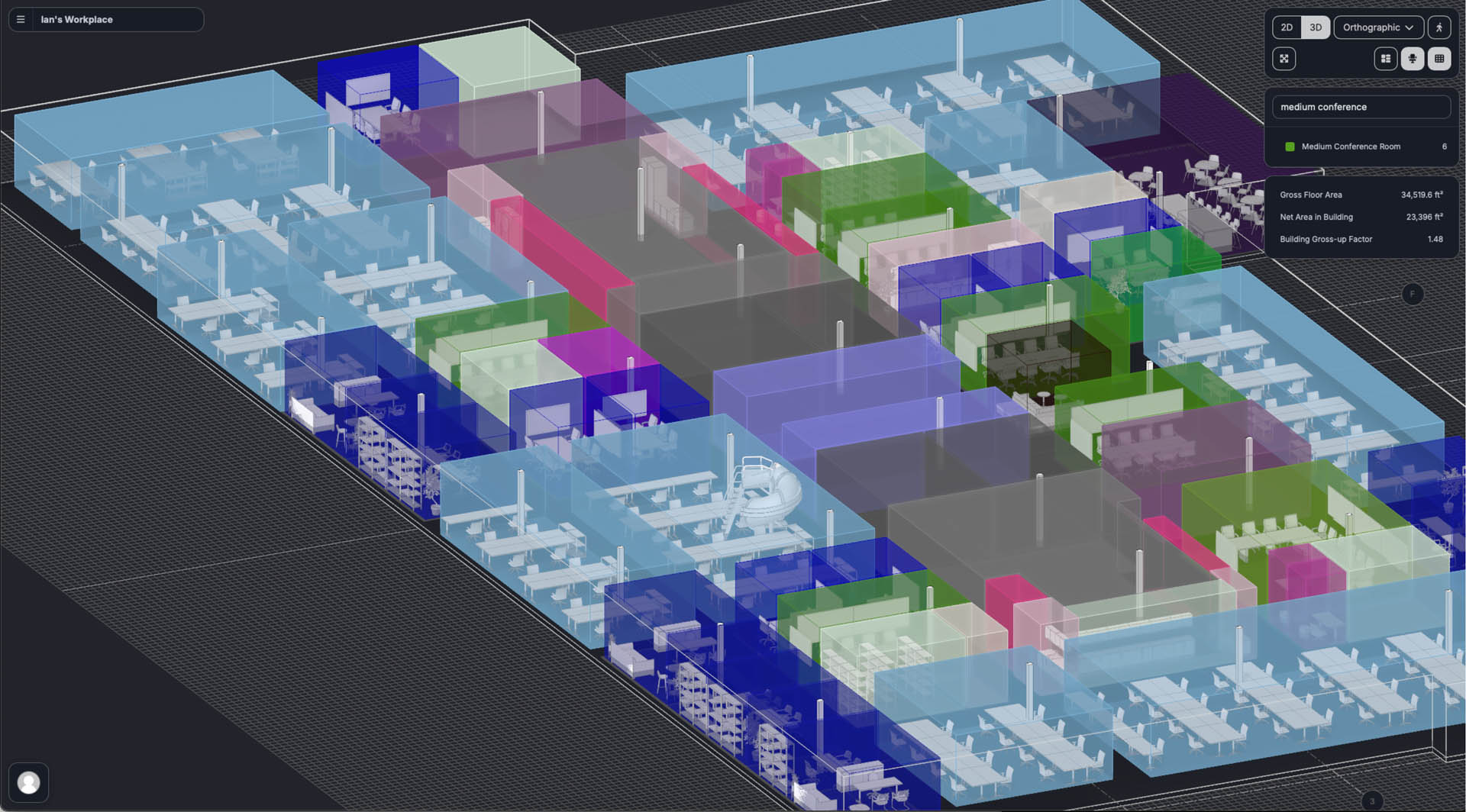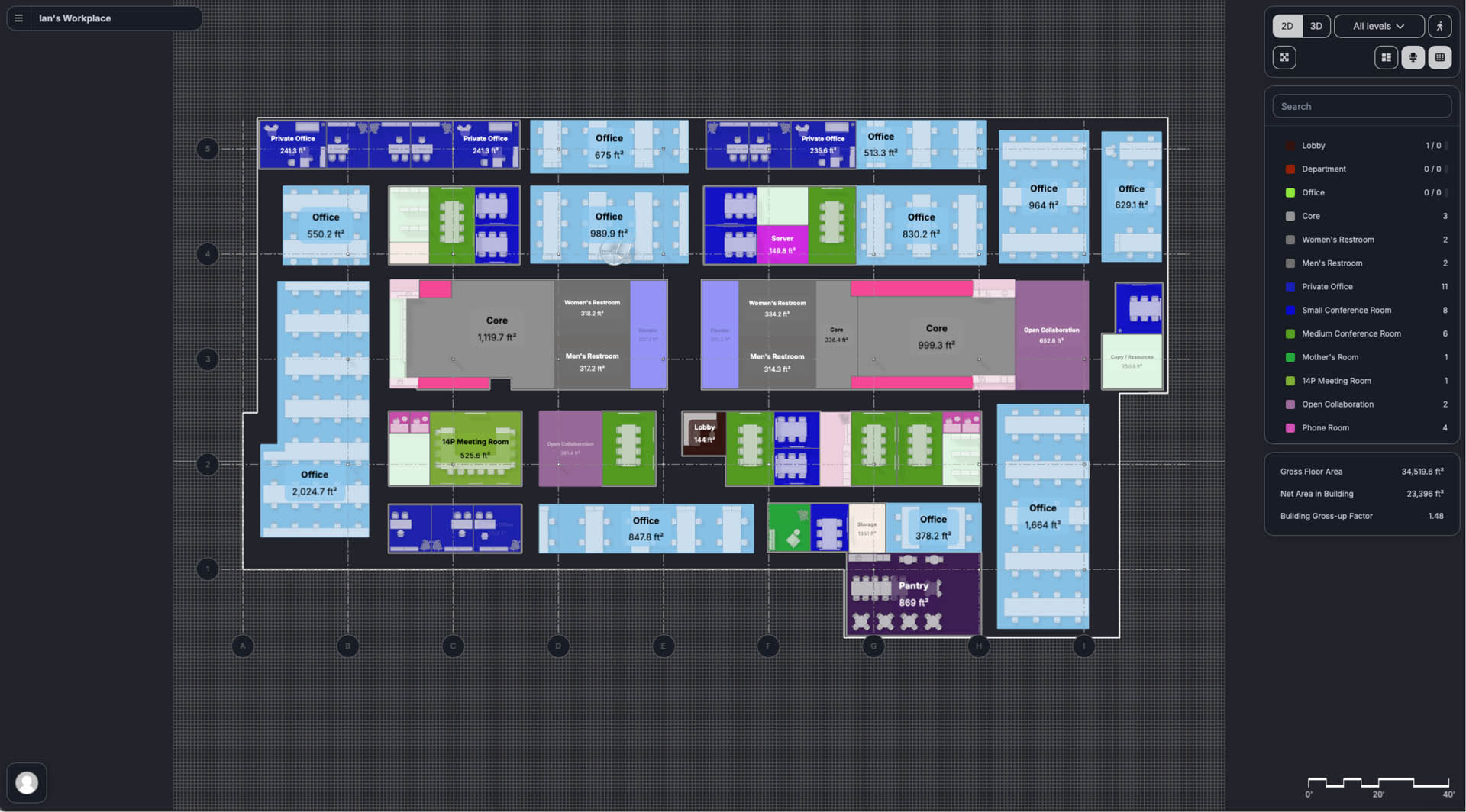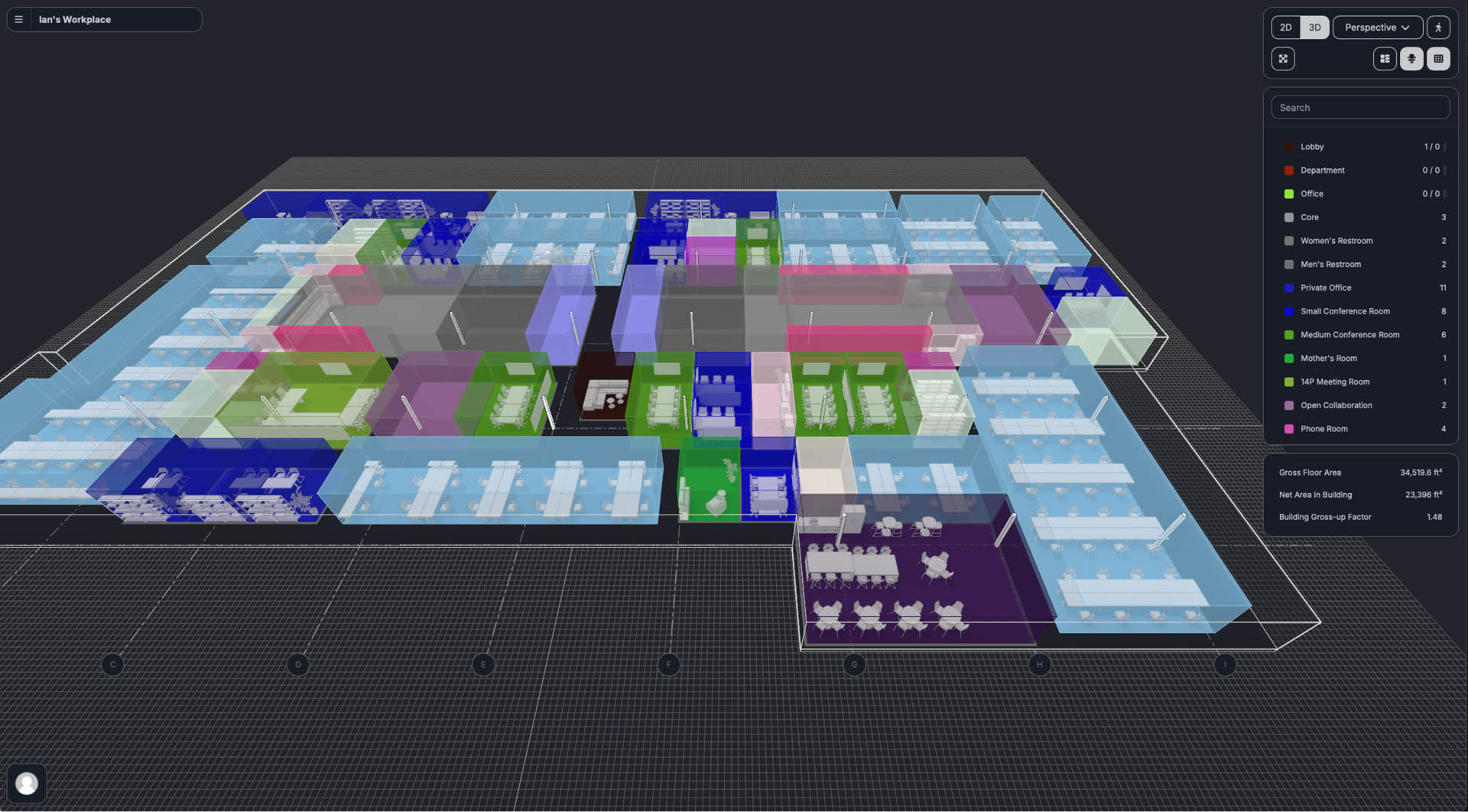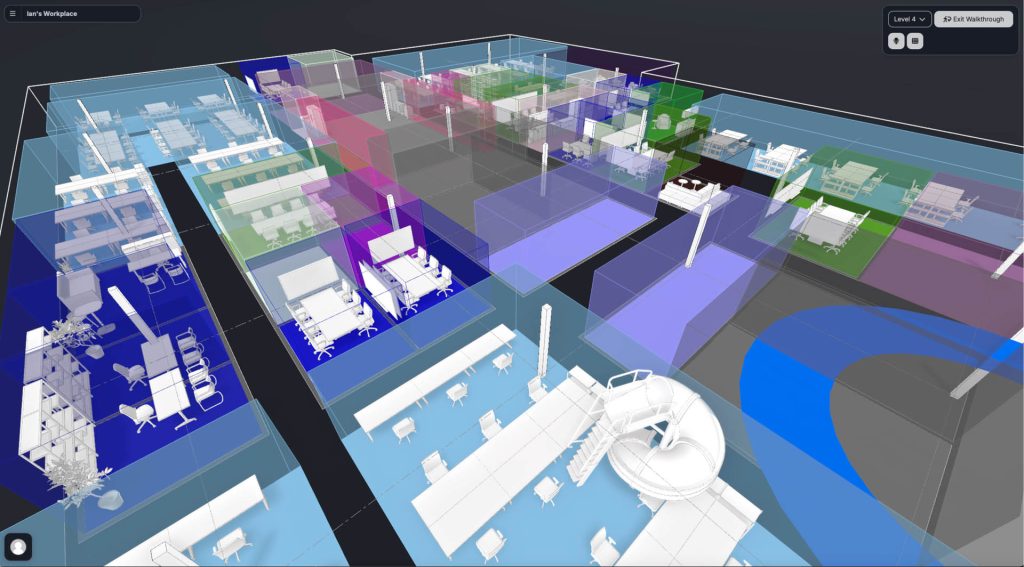Towards the end of 2024, software developer Hypar released a whole new take on its cloud-based design tool, focused on space planning and with a cool new web interface. Martyn Day spoke with Hypar co-founder Ian Keough to get the inside track on this apparent pivot
Founded in 2018 by Anthony Hauck and Ian Keough, Hypar has certainly been on a journey in terms of its public-facing aims and capabilities.
Both co-founders are well-established figures in the software field. Hauck previously led Revit’s product development and pioneered Autodesk’s generative design initiatives. Keough, meanwhile, is widely recognised as the creator of Dynamo, a visual programming platform for Revit.
Initially, their creation Hypar looked very much like a single, large sandpit for generative designers familiar with scripting, enabling them to create system-level design applications, as well as for nonprogrammers looking to rapidly generate layouts, duct routing and design variations and get feedback on key metrics, which could then be exported to Revit.
Find this article plus many more in the Jan / Feb 2025 Edition of AEC Magazine
👉 Subscribe FREE here 👈
Back in 2023, we were blown away with Hypar’s integration of ChatGPT at the front end. This aimed to give users the ability to rapidly generate conceptual buildings and then progress on to fabrication-level models. This capability was subsequently demonstrated in tandem with DPR Construction.
One year later and the company’s front end has changed yet again. With a whole new interface and a range of capabilities specifically focused on space planning and layout, it feels as if Hypar has made a big pivot. What was once the realm of scripters now looks very much like a cloud planning tool that could be used by anyone.
AEC Magazine’s Martyn Day caught up with the always insightful Ian Keough to discuss Hypar’s development and better understand what seems like a change in direction at the company, as well as to get his more general views on AEC development trends.
Martyn Day: Developers such as Arcol, Snaptrude and Qonic are all aiming firmly at Revit, albeit coming at the market from different directions and picking their own entry points in the workflow to add value, while supporting RVT. Since Revit is so broad, it seems clear that it will take years before any of these newer products are feature-comparable with Revit, and all these companies have different takes on how to get there. With that in mind, how do you define a nextgeneration design tool and what is Hypar’s strategy in this regard?
Ian Keough: At Hypar, we’ve been thinking about this problem for five or six years from a fundamentally different place. Our very first pitch deck for Hypar showed images from work done in the 1960s at MIT, when they were starting to imagine what computers would be used for in design. They weren’t imagining that computers would be used for drafting, of course. Ivan Sutherland had already done that years before and we have all seen those images.
I think there are a lot of people who have very uninteresting ideas around AI in architecture, and those involve things like using AI to generate renderings and stuff like that. It’s nifty to look at, but it’s so low value in terms of the larger story of what all this computing power could do for us – Ian Keough
What they were imagining is that computers would be used to design buildings, and they were making punch card programmes to lay out hospitals and stuff and that. To me, that’s a very pro-future kind of vision. It imagined that computing capacity would grow to a point where the computer would become a partner in the process of design, as opposed to a slightly better version of the drafting board.
However, when it eventually happened, AutoCAD was released in the 1980s and instead we took the other fork of history. The result of taking that other fork has been interesting. If you look at this from a historic perspective, computers did what they did and they got massively more powerful over the years. But the small layer on top of that was all of our CAD software, which used very little of that available computing power. In a real sense, it used the local CPU, but not the computing power of all the data centres around the world which have come online. We were not leveraging that compute power to help us design more efficiently, more quickly, more correctly. We were just complaining that we couldn’t visualise giant models, and that’s still a thing that people talk about.


That’s still a big problem for people’s workloads. I don’t want to dismiss it. If you’re building an airport, you have got to load it, federate all of these models and be able to visualise it. I get that problem. But the larger problem is that, i n order to get to that giant model that you’re complaining about, there are many, many years of labour, of people building in sticks-and-bricks models. How many airports have we designed in the history of human civilisation?
So, thinking about the fork we face – and I think we’re experiencing a ‘come to Jesus’ moment here – people are now seeing AI. As a result, they’re getting equal parts hopeful that it will suddenly, at a snap of the fingers, remove all the toil that they’re experiencing in building these bigger and bigger and more complicated models, and equal parts afraid that it will embody all the expertise that is in their heads, and will leave them out of a job!
Martyn Day: I can envisage a time where AI can design a building in detail, but I can’t see it happening in our lifetime. What are your thoughts?
Ian Keough: I don’t think that’s the goal. I don’t think that’s the goal of anybody out there – even the people who I think have the most interesting and compelling ideas around AI and architecture. But I do think there are a lot of people who have very uninteresting ideas around AI in architecture, and those involve things like using AI to generate renderings and stuff like that. It’s nifty to look at, but it’s so low value in terms of the larger story of what all this computing power could do for us.
At AEC Magazine, you’ve already written about experiments that we’ve conducted in terms of designing through our chat prompt/text-to-BIM capability. So, we took the summation of the five years of work that we have done on Hypar as a platform, the compute infrastructure and, when LLMs came along, Andrew Heumann on our team suggested it would be cool if we could see if we could map human natural language down into input parameters for our generative system.
We did that. We put it out there. And everybody got really, really excited. But we quickly realised the limitations of that system. It’s very, very hard to design anything real through a check prompt. It’s one thing to generate an image of a building. It’s another thing to generate a building. You’ll see in the history of Hypar that the creation of this new version of the product directly follows the ‘text-to-BIM thing’, because what the ‘text-to-BIM thing’ showed us is that we have this very powerful platform.

The new Hypar 2.0, which was released in September 2024, and more specifically, the layout suggestions capability, was our first nod towards AI-infused capabilities. The platform is all about seeing if we can make a design tool that’s a design tool first and foremost.
The problem with AI-generated rendering is you get what you get, and you can’t really change it, except for changing that prompt, and you’re totally out of control. What designers want is control. They want to be able to move quickly and to be able to control the design and understand the input parameters design. Hypar 2.0 is really about that. It’s about how you create a design tool and then lift all of this compute and seamlessly integrate it with the design experience, so that computation is not some other experience on top of your model.
Martyn Day: Historically, we have been used to seeing Hypar perform rapid conceptual modelling through scripting, generate building systems and be capable of multiple levels of detail to quickly model and then swap out to scale fidelity. The whole Hypar experience, looking at the website now, seems to be about space planning. Would you agree?
Ian Keough: That’s the head-scratcher for a lot of people when it comes to this new version. People who have seen me present on the work we did with DPR and other firms to make these incredibly detailed and sophisticated building systems are saying, “Wait, now you’re a space planning software now?”
That may seem like a little bit of a left turn. But the mission continues to enable anyone to build really richly detailed models from simple primitives without extra effort. We do this in the same way that we could take a low-resolution Revit wall and turn it into a fully clad DPR drywall layout, including all the fabrication instructions and the robotic layout instructions that go on the floor, and everything else. That capability still lives in Hypar, underneath the new interface.
What we are doing is getting back to software that solves real problems, again. This is a very gross simplification of what’s going on, but what problem does Revit actually solve? The answer is drawings, documentation. That’s the problem that Revit solves today and has solved since the beginning. What it does not solve is the problem of how to turn an Excel spreadsheet that represents a financial model into the plan for a hospital. It does not solve that at all. That is solved by human labour and human intellect. And right now, it’s solved in a very haphazard way, because the software doesn’t help you. It doesn’t offer you any affordances to help you do that. Everybody is largely either doing this as cockamamie-crazy, nested-family Lego blocks and jelly cubes in Revit, or trying to do it as just a bunch of coloured polygons in Bluebeam. That’s not how we’re utilising compute.
At the end of a design tool, it is still the architect’s experience and intellect that creates a building. What the design tool should do is remove all of the toil.
To give you an example of this, now that we’ve reached a point where users can use our software in a certain production context, to create these larger space plans, they’re starting to ask for the next layer of capabilities such as clearances as a semantic concept. This is the idea that, if I’m sitting at this desk, there should be a clearance in front of this desk, so that people have enough room to walk by. Sometimes, clearances are driven by code – so why has no piece of architectural design software in the last 20 years had a semantic notion of a clearance that you could either set specifically or derive from code? You might be able to write a checker in Solibri in the postdesign phase, but what about the designer at the point of creating the model?
Clearances are just one example. There are plenty of others, but the other impetus for a lot of what we’re doing right now is the fact that organisations like HOK have a vast storehouse of encoded design knowledge, in the form of all of the work that they’ve done in the past. Often, they cannot reuse this knowledge, except by way of hiring architects and transmitting this expertise from one person to the next, in a form that we have used for thousands of years – by storytelling, right?
What firms want is a way to capture that knowledge in the form of spaces, specific spaces, and all the stuff that’s in a space and the reasons for that stuff being there. And then they just want to transfer that knowledge from one project to another, whether it’s a healthcare project or any other kind of project that they’ve carried out before.
At the beginning of defining the next version of Hypar, when we started talking with architects about this problem, I was amazed by the cleverness of the architects. They’re actually finding solutions to do this with the software they have now. They build these giant, elaborate Revit models with hundreds of standard room types in them, and then they have people open those Revit models and copy and paste out stuff from the library.
I had one guy who referred to his model as ‘the Dewey Decimal System’. He had grids in Revit numbered in the Dewey Decimal System manner, such that he could insert new standards into this crazy grid system. And he referred to them by their grid locations.
In other words, architects have overcome the limitations that we’ve put in place in terms of software. But why isn’t it possible in Revit to select a room and save it as a standard, so the next time I put a room tag in that set exam room, such as a paediatric exam room, it just infills it with what I’ve done for the last ten projects.
To get back to your question about what the next generation looks like, I guess the simplest way to explain how we’re approaching it is that we’re picking a problem to solve that’s at the heart of designing buildings. It’s at the moment of creation, literally, of a building. We want to solve that problem and use software as a way to accelerate the designer, rather than a way to demonstrate that we can visualise larger models. That will come in time, but really, we want to use this vast computational resource that we have to undergird this sort of design, and make a great, snappy, fun design tool.
Martyn Day: Old BIM systems are oneway streets. They are about building a detailed model to produce drawings. But you have gone on record talking about tasks that need different levels of abstraction and multiple levels of scale, depending on the task. Can you explain how this functions in Hypar?
Ian Keough: You’ll notice in the new version of Hypar that there’s something called ‘bubble mode’. It’s a diagram mode for drawing spaces, but you’re drawing them in this kind of diagrammatic, ‘bubbly’ way.
That was an insight that we gleaned from spending literally hundreds of hours watching architects at the very early stage of designing buildings. They would use that way of communicating when they were doing departmental layout or whatever. They were hacking tools like Miro and other things, where they were having these conversations to do this stuff. But it was never at scale.
We were already thinking of this idea of being able to move them from lowlevel detail to a high level of detail without extra effort by means of leveraging compute. Now, in Hypar, and I’ll admit the bits are not totally connected yet in this idea, you’ll notice that people will start planning in this bubble mode, and then they’ll have conversations around bubble mode, at that level of detail.
Meanwhile, the software is already working behind the scenes, creating a network of rooms for them. And then they’ll perform the next step and use this clever stuff to intelligently lay out those rooms, the contents in the rooms. The next level of detail passed that will be connectors to other building systems, so let’s generate the building system. There’s this continuous thread that follows levels of detail from diagram to space – to spaces with equipment and furniture and to building systems.
Martyn Day: We have seen Hypar focus on conceptual work, space planning, fabrication-level modelling. Is the goal here to try and tackle every design phase?
Ian Keough: We’re marching there. The great thing about this is that there’s already value in what we offer. This is something that I think start-ups need to think about. You’re solving a problem, and if you want to make any money at all, that problem needs to have value at every point along the trajectory. That’s unless you raise a ton of capital, and say, ‘Ten years from now, we’ll have something that does everything.’
The reality is at day five, after you’ve built some software, and you put it in customers’ hands, that thing has to have value for them. The good news is that just in the way that we design buildings now, from low-level detail to high-level detail, there’s value in all those places along the design journey.
Why isn’t it possible in Revit to select a room and save it as a standard, so the next time I put a room tag in that set exam room, such as a paediatric exam room, it just infills it with what I’ve done for the last ten projects
The other thing that I think is going to happen, to achieve what we’ve been envisioning since the beginning of Hypar, is fully generated buildings. I do not believe in the idea that there’s this zerosum game that we’re all playing, where somebody’s going to build the one thing that ‘owns the universe’.
This is a popular construct in people’s minds, because they love this notion of somebody coming along and slaying the dragon of Revit in some way, and replacing it with another dragon.
What’s going to happen is, in the same way that we see with massively connected systems of apps on your phone and on the internet, these things are going to talk to each other. It’s quite possible that the API of the future for generating electrical systems is going to be owned by a developer like Augmenta (www.augmenta.ai). And since we’re allowing people to layout space in a very agile way, Hypar plugs into that and asks the user, ‘Would you like this app to asynchronously generate a system for you?’
Now, it might be that, over Hypar’s lifetime, there will be real value in us building those things as well, because most of the work that we’re doing right now is really about the tactility of the experience. So it might be that, to achieve the experience that we want, we have to be the ones who own the generation of those systems as well, but I can’t say yet whether or not that’s the case.
Everything we’re doing right now in terms of the new application is around just building that design experience. What we do in the next six months to one year, vis-à-vis how we connect back into functions that are on the platform and start to expose that capability, I can’t speculate right now.
What we need to do is land this thing in the market and then get enough people interested in using it, so that it starts to take hold. Some of the challenge in doing that is what you alluded to earlier, which is that people are trying to pigeon-hole you. They’ll ask, ‘Are you trying to kill Revit?’, or, ‘Are you trying to kill this part of the process that I currently do in Revit?’ That’s a challenge for all start-ups.
The decision that we made to rebuild the UI is about the long-term vision we have for Hypar. That vision has always been to put the world’s building expertise in the hands of everyone, everywhere. And if you think about that longterm vision, everybody will have access to the world’s building expertise. But how do they access it? If it’s through an interface that only the Dynamo and Grasshopper script kids can use or want to use, then we will not have fulfilled our vision.








